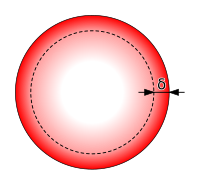
Photo from wikipedia
We have numerically investigated the transmission of an antisymmetric Lamb wave through a line of silicon pillars erected onto a homogeneous silicon plate when the frequency is tuned to a… Click to show full abstract
We have numerically investigated the transmission of an antisymmetric Lamb wave through a line of silicon pillars erected onto a homogeneous silicon plate when the frequency is tuned to a resonant frequency of the pillars. For either a bending mode or a compressional mode, the resonators emit in the plate a wave 180° out-of-phase with the exciting Lamb wave, resulting in dips in the transmission spectrum. We show that transmission at resonance can be actively controlled by applying an external force, either tangential (bending eigenmode) or axial (compressional eigenmode), on top of the pillars. The transmission coefficient can be precisely controlled by finely tuning either the phase or the amplitude of the external force. For specific dimensions of the structure, both resonant modes arise at the same frequency. This geometry has the advantage of offering an additional degree of freedom for the direction of the external force but is less favorable from an energy point of view.
Journal Title: Journal of Applied Physics
Year Published: 2020
Link to full text (if available)
Share on Social Media: Sign Up to like & get
recommendations!